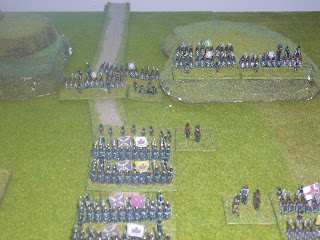Situation:
With Wellington's forces about to invest the fortress of Ciudad Rodrigo, Marshal Marmont has come up with an imaginative plan to disrupt Wellington's preparations. The French Marshal has swung part of his forces to attack the British covering force on the left-wing knowing that a severe reverse to the Anglo-Portuguese here will at worse demoralize the besiegers, and at best force Wellington to withdraw to re-organize, thus gaining vital additional time for the besieged to get supplies and reinforcements into the city.
Marmont has given Gen Sauret a force of two infantry divisions and two cavalry divisions to carry out this mission. Sauret plans to pin the forces of Gen Berwick opposite, whilst sending an outflanking force to turn the Allied position. As the morning mist clears, Berwick sees the French turning movement, but looks to be too late to prevent them seizing the bridge...
Allied Forces: C-in-C Gen Berwick
1st Division: Gen Robson (Competent)
1st Brigade: 2 Queen's Royal, 68th (Durham) Light, 2/92 Gordon Highlanders, 5/1 RA (6lb)
2nd Brigade: 2 Cacadores, 6 Line, 7 Line, 8 Line, 22 Line (V)
2nd Division: Gen Charlton (Decisive)
1st Brigade: 1/5 Northumberland, 3/27 Inniskillings, 1/52 Light Oxfordshire (Light), 55 Westmoreland
2nd Brigade: 4th Queen's Own Dragoons, 6th Inniskilling Dragoons
3rd Brigade: 3rd Prince of Wales' Dragoon Guards, 5th Princess Charlotte of Wales' Dragoon Guards, Ross' Troop RHA (6lb)
1st Light Cavalry Brigade: 9th Light Dragoons, 16th Queen's Light Dragoons
2nd Light Cavalry Brigade: 10th Prince of Wales Own Hussars, 15th King's Hussars
Imperial Forces: C-in-C Gen Sauret
1st Division: Gen Renault (Competent)
1st Brigade: 2/113 Line, 3/113 Line, 1/119 Line, Irish Legion
2nd Brigade: 1/28 Light, 1/32 Light, 1/113 Line, 1/116 Line
3rd Brigade: 1/94 Line, 1/95 Line, 1/118 Line, 1/2 Nassau Infantry
Divisional Artillery: 1/1 Foot Artillery (8lb)
2nd Division: Gen Panis (Competent)
1st Brigade: 2/28 Light, 3/28 Light, 1/96 Line, 1/117 Line
3rd Division: Gen Arnoux (Decisive)
1st Brigade: 5 Chasseurs, 17 Chasseurs
2nd Brigade: 1 Hussars, 6 Hussars, 1/2 Horse Artillery
4th Division: Gen Villeneuve (Competent)
1st Brigade: 1 Dragoons, 10 Dragoons
2nd Brigade: 19 Dragoons, 22 Dragoons
Initial Positions:
 |
| View of the Allied right |
And also:
 |
| The opposing forces race for the unguarded bridge...but the French have the headstart and their cavalry is faster.... |
The conflict begins on the Allied left:
 |
| French Chasseurs have crossed the bridge first, but the British Dragoons are in position to charge... |
|
|
|
 |
| A couple of successful charges by the Dragoons have seen off the French Light Cavalry and two battalions of French infantry...but the third French infantry battalion has succeeded in forcing and holding the bridge... |
|
 |
| The final charge of the Dragoons results in heavy casualties, but the French commander loses his nerve and retreats, as the British infantry approaches |
As the flanking attack faltered, Gen Sauret tried a frontal attack:
 |
| The French infantry approach the main Allied position while the French dragoons try to find a gap round the extreme Allied Right... |
 |
| The French Dragoons have crossed the stream, outflanked the Portuguese infantry and broken one of the British Hussar regiments - the other has withdrawn to the high ground and is now supported by the reserve Portuguese infantry Bn |
|
|
 |
| The situation at the end of the battle: the French infantry have made some progress against the 2 Foot supported by Light Dragoons on the left and against the Portuguese brigade on the right, but the central French brigade has been put to flight by the 68th Light Infantry and 2/92 Gordon Highlanders; meanwhile the French dragoons have seen off the second British hussar regiment, but been defeated in turn by the Portuguese infantry facing the flank. At this point French morale collapsed and they withdrew. |
Another very enjoyable battle, with some mistakes made on both sides. After the first few turns I thought the French were going to get a one-sided trouncing, but they pulledit back to make it a close-run thing.
I rated the performance of the units as follows:
Allies:
6th Inniskilling Dragoons 3*, 5th Princess Charlotte's Dragoon Guards 3*, 2 Foot 2*,
2/92 Gordons 2*, 68th 2*, 2 Cacadores 2*, 7 Line 3*, 6 Line 2*, 10th Hussars 1*
French:
1/96 Line 2*, 3/28 Light 1*, 1/119 Line 2*, 1/32 Light 2*, 1/28 Light 2*, 1 Dragoons 3*
The Commanders: Sauret 1*, Villeneuve 2*, Renault 1*, Arnoux -2*, Berwick -1*
Broken:
17 Chasseurs, 3/113 Line, 1/94 Line, 1/118 Line, 1/113 Line, 1/116 Line, 2/28 Light, 1/117 Line
10 Hussars, 15 Hussars
As a result of this, the following units were promoted to Veteran:
5th Princess Charlotte's Dragoon Guards, 7 Line, 6 Line, 10th Hussars
3/28 Light, 1/28 Light,
The following units are now Raw:
17 Chasseurs, 1/94 Line, 1/113 Line, 1/116 Line, 2/28 Light, 1/117 Line
15 Hussars
Gen Villeneuve is now rated as Decisive.
Game Notes:
The game was played with the
Polemos Napoleonics General de Division rules. The scenario is based closely on the second one in
Scenarios for All AgesAll troops were rated as Trained except the Portuguese 22 Line. Light Infantry units were rated as
SK2, all other infantry as SK1. The Light Dragoons were rated as Light
Cavalry. The game lasted 11 turns before French morale collapsed.







.JPG)
.JPG)





.JPG)
.JPG)






.JPG)






















